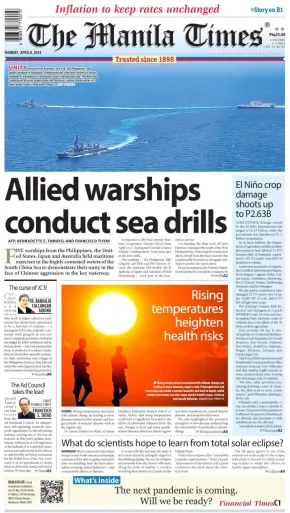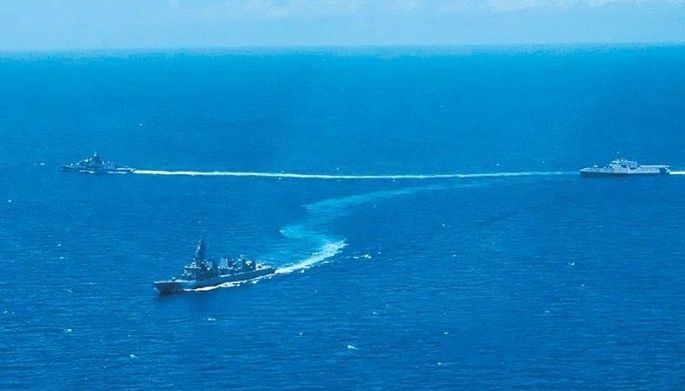HEADLINE-GEO POLITICS | West Philippine Sea: ‘Allied warships conduct sea drills’
WATCH VIDEO: Philippines, US, Japan, Australia hold maritime drills as tension lingers in West PH Sea
…
AFP: Naval drills in West Philippine Sea successful
Unity Vessels from Australia, the USA, the Philippines, and Japan navigate in formation, symbolizing the collective resolve to ensure freedom of navigation in accordance with international law. The Maritime Cooperative Activity underscored the countries’ shared commitment to a rules-based order in maritime conduct. AFP photo
.
.

FIVE warships from the Philippines, the United States, Japan and Australia held maritime exercises in the highly contested waters of the South China Sea to demonstrate their unity in the face of Chinese aggression in the key waterway.
In response to the four-country Maritime Cooperative Activity (MCA) from April 6 to 7, Beijing said it would conduct military “combat patrols” in the same area as the joint drills.
Five warships — the Philippines’ BRP Gregorio del Pilar and BRP Ramon Alcaraz, the American USS Mobile, the JS Akebono of Japan and Australia’s HMAS Warramung — took part in the four-nation exercise.
On Saturday, the ships took off from Palawan, cruising to the south of the West Philippine Sea. Protecting the vessels were attack aircraft from the four countries that conducted fly-by missions alongside warships to protect the naval assets.
In a joint statement, the Defense Department said the MCA would be conducted by naval, maritime and air force units “in a manner that is consistent with international law as well as domestic laws and rules of respective nation, and with due regard to the safety of navigation and the rights and interest of other states.”
As the joint sail proceeded, the Chinese People’s Liberation Army Southern Theater Command said it had organized a joint naval and air strategic patrol in the SCS on April 7.
“All military activities disrupting the South China Sea situation and creating buzzes are under control,” said the PLA Southern Theater Command in a statement Sunday.
Defense Department Information Officer Director Arsenio Andolong said they expected China to malign the ongoing maritime exercise through propaganda.
Andolong rejected the allegation that the MCA was aimed at provoking China.
“It’s being conducted from time to time. We’ve had lots of MCA before. I don’t think the tension [rose] considerably during that time; it’s just that we are always bombarded by their rhetoric,” Andolong said.
He said the MCA was a show of unity, not force.
“If they consider it a show of force, that’s up to them, but what we’re doing is something that’s practiced by all civilized nations in the world,” Andolong said.
“What is important is that we are doing this in the name of our national interest in the Philippines because, as I mentioned, what we’re getting out of this is the enhancement of our capability and our interoperability with our partners,” he added.
The US, Japan, Australia and France are expected to hold a maritime sail in international waters fronting the South China Sea but within the Philippine EEZ during the forthcoming Balikatan Exercises 2024 later this month.
Other countries like the United Kingdom, Canada, Germany and India have expressed interest in participating in the upcoming MCA while supporting the Philippines in its stand on the WPS.
The Chinese announcement of their combat patrols came one day after defense chiefs from four countries, including the Philippines, which has been engaged in several contentious maritime disputes with Beijing recently, said they would conduct joint drills on Sunday in the area.
Beijing’s People’s Liberation Army (PLA) Southern Theater Command said it was organizing “joint naval and air combat patrols in the South China Sea.”
Further details about the Chinese military activities in the waterway on Sunday were not announced.
The exercises take place days before US President Joe Biden is due to hold the first three-way summit with President Ferdinand Marcos Jr. and Japanese Prime Minister Fumio Kishida.
Top US officials have repeatedly declared the United States’ “ironclad” commitment to defending the Philippines against an armed attack in the South China Sea — to the consternation of Beijing.
China claims territorial sovereignty over nearly all of the South China Sea and has been increasingly assertive in the region in recent years. In 2016, a tribunal constituted under the United Nations Convention on the Law of the Sea (Unclos) said there was no legal basis for China’s expansive claims, but Beijing has refused to recognize the decision.
China’s Coast Guard said Saturday it had “handled” a situation on Thursday at a disputed reef where several ships from the Philippines were engaged in “illegal” operations.
“Under the guise of ‘protecting fishing,’ Philippine government ships have illegally violated and provoked, organized media to deliberately incite and mislead, continuing to undermine stability in the South China Sea,” spokesman Gan Yu said.
“We are telling the Philippines that any infringement tactics are in vain,” Gan said, adding that China would “regularly enforce the law in waters under (its) jurisdiction.”
Beijing has brushed aside competing territorial claims by several Southeast Asian countries in the South China Sea — a crucial route for global trade — as well as the international ruling that declared its stance baseless.
The drills conducted Sunday by the Philippines, United States, Japan and Australia are intended to “[ensure] that all countries are free to fly, sail, and operate wherever international law allows,” US Defense Secretary Lloyd Austin said in a joint statement.
The Japanese embassy in Manila said in a statement that “anti-submarine warfare training” would be included in the drills.
Last week, Australian warship HMAS Warramunga arrived at the Philippine island of Palawan, which faces the hotly contested waters.
Stability
Sen. Francis Tolentino said the quadrilateral naval exercise would ensure stability in the region and was not meant to provoke China.
“To the contrary, this would ensure stability in the region; China is not being provoked but being made to realize that peace and stability in the region is likewise to serve their interests,” Tolentino said in a statement.
The Japanese Embassy in Manila said Japan’s Maritime Self-Defense Force deployed JS Akebono, a Murasame-class destroyer, to join the drill with the US Navy, Australian Navy and Air Force, and the Philippine Navy.
The deployment of JS Akebono was part of the Philippines-US-Australia-Japan Maritime Cooperative Activity (MCA) in the South China Sea, the embassy said in a statement.
The MC aimed to enhance regional maritime security cooperation among the four countries and promote freedom of navigation toward the realization of a “free and open Indo-Pacific,” the embassy said.
In a joint statement with the Defense heads of Australia, the Philippines and the US, Japan’s Minister of Defense Kihara Minoru underscored the importance of cooperating with like-minded countries to ensure regional peace and stability.
Kihara also said the issue concerning the SCS “is directly related to the peace and stability of the region and a legitimate concern of the international community and expressed Japan’s opposition towards any unilateral attempts to change the status quo by force in the region.”
The statement was jointly issued on April 6 by Australian Minister of Defense Richard Marles, Defense Secretary Gilberto Teodoro Jr., and US Defense Secretary Lloyd James Austin 3rd.
The defense chiefs said their countries “uphold the right to freedom of navigation and overflight, and respect for maritime rights under international law, reflected in the United Nations Convention on the Law of the Sea.”
“We stand with all nations in safeguarding the international order–based on the rule of law–that is the foundation for a peaceful and stable Indo-Pacific region,” they said.
-
04:59Today’s Weather, 4 A.M. | Apr. 8, 2024
-
00:39WPS Maritime Cooperative Activity


 Memento Maxima Digital Marketing
Memento Maxima Digital Marketing







